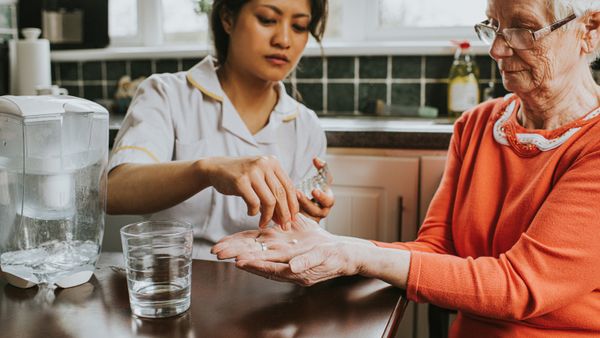As you age your vitamin needs will change from what they were as a younger person. Follow these guidelines for the proper intake of vitamins.
Vitamin A
There are only a handful of foods that provide "preformed" vitamin A, or retinol. These include fortified milk, liver, fish liver oils, and eggs. Preformed vitamin A is also typically found in vitamin supplements. But unless you eat large portions of animal foods or take supplements with preformed vitamin A in them, chances are most of your vitamin A will come from plant foods.
Colorful plant foods are rich in carotenoids, especially beta-carotene, which the body is able to convert to vitamin A. Look for bright orange, red, yellow, and green fruits and vegetables. Their bright colors signal that they are good sources of carotenoids.
Avoid vitamin A supplements unless specifically recommended by your doctor. If you take a multivitamin, choose one that gets most or all of its vitamin A content from beta-carotene, the safest form of this vitamin, rather than from retinol, which can accumulate to toxic levels in the body.
Here is a list of foods that are high in carotenoids:
- Brussels sprouts
- Cantaloupe
- Carrots
- Kale
- Mango
- Peppers, red or green
- Pumpkin
- Romaine lettuce
- Spinach
- Sweet potatoes
- Winter squash
Riboflavin
The principle sources of riboflavin in the diet are milk and yogurt, though whole grains, wheat germ, and eggs are rich sources as well. Because riboflavin is sensitive to light, milk stored in see-through plastic jugs and glass containers is likely to have lost some of the vitamin during storage.
More riboflavin is likely to be retained in milk sold in cardboard cartons. Most multivitamins provide about 100 percent of the recommended intake for riboflavin, but some "B formula" supplements have even higher levels of all the "B's."
Here is a list of foods that are high in riboflavin:
- Almonds
- Asparagus
- Chicken thighs
- Fortified breakfast cereals
- Milk
- Turkey
- Wheat germ
- Whole-grain or enriched bread
- Yogurt
Vitamin B6
Foods rich in protein, such as chicken, fish, and pork, are also rich in vitamin B6. Refined grains are low in vitamin B6 because the B vitamins are generally removed during the refining process. While enriched breads have other B vitamins added back, B6 isn't one of them. Fortified cereals, however, are good sources of the vitamin.
Though B6 is considered a safe vitamin, experts discovered several years ago that if you take more than one gram a day for an extended period of time, it can cause temporary tingling and loss of feeling in your hands and feet. When you stop taking such large amounts, the symptoms should go away.
Here are foods that are high in vitamin B6:
- Bananas
- Beef
- Bran flakes
- Fish
- Spinach
- Wheat germ
Vitamin B12
Vitamin B12 is unique to animal tissues, so it's not found naturally in plants or plant food products. However, it is added to most fortified breakfast cereals, making them a good source of the vitamin. It takes only a small, 4-ounce serving of lean beef to provide all the vitamin B12 you need for the day. Three ounces of drained, canned light tuna also satisfies daily requirements.
Vegans, vegetarians who shun all animal products, are at risk for a B12 deficiency if they don't also take a vitamin supplement or eat a fortified cereal. Most supplements provide 100 percent of the recommended intake for the vitamin, but taking larger amounts is safe.
The following are foods that are high in vitamin B12:
- Beef
- Cheese
- Chicken
- Eggs
- Milk
- Salmon
- Tuna
- Turkey
Folate
Folate is one of the rare instances in which the synthetic form, folic acid, is actually better absorbed by the body than the natural form found in foods. So, fortified cereals and vitamin supplements (both of which use folic acid) are excellent sources of folate.
In fact, the law requires folic acid to be added to enriched breads and grains. In supplements it is often found in combination with other B vitamins, especially B6 and B12, since they all work together to prevent the buildup of homocysteine in the blood.
Here is a list of foods that are high in folate:
- Asparagus
- Bananas
- Beets
- Chickpeas
- Enriched bread, pasta, and rice
- Lentils
- Orange juice
- Spinach
- Turnip greens
- Wheat germ
Choline
Choline is primarily found in meats and dairy and soy products, but it can also be found in lesser amounts in other foods, such as fish and vegetables. Eggs, including the yolks, and organ meats have the highest amount of choline. In fact, one egg provides about half your daily recommended intake.
Most people get an adequate amount of choline from the foods they eat, so choline supplements are not necessary if you eat a balanced, varied diet. However, because many of the foods highest in choline are also high in saturated fat and cholesterol, moderate your intake.
Here is a list of good sources of choline:
- Bacon
- Beef
- Chicken
- Eggs
- Organ meats
- Pork
- Salmon
- Wheat germ
Vitamin C
Some nutrients are hard to get by diet alone, but vitamin C isn't one of them. Load up on fruits and vegetables, and you've got it made. Even the saturation level of 200 milligrams a day can easily be figured into your daily diet.
If you opt for supplements, there is no need to go over 400 milligrams a day, since the extra C appears to offer no health benefit. If you take more than 1,000 milligrams a day, you could trigger diarrhea and cramps.
These foods will help you get your dosage of vitamin C:
- Broccoli
- Brussels sprouts
- Cantaloupe
- Cauliflower
- Cranberry juice cocktail
- Grapefruit
- Mango
- Orange juice
- Peppers, green or red, sweet
- Strawberries
- Swiss chard
- Tomatoes
Vitamin D
Few foods actually contain vitamin D in its ready-to-use form. Fortified breakfast cereals may provide approximately 40 to 50 International Units (IU) of vitamin D, but this amount does not ensure adequate intake. Even in milk the levels of vitamin D vary considerably. That's why it's a good idea to get at least some exposure to the sun, which allows your skin to make up the difference by manufacturing D on its own.
To ensure adequate intake of vitamin D, it's best to take a multivitamin with 400 IU of vitamin D and eat a balanced diet. Limit your intake -- from food sources and supplements -- to an absolute maximum of 2,000 International Units, or 50 micrograms, a day. Taking more could spell trouble and put you at risk for weakened bones.
The following foods are all good sources of vitamin D:
- Cod liver oil
- Eggs
- Fortified breakfast cereals
- Margarine
- Milk
Vitamin E
There's much disagreement over how much E is enough to keep you healthy. The official recommended intake is 15 milligrams of alpha-tocopherol a day, which is easy to obtain from your diet with a little planning. But some evidence suggests that you need far more than that amount for antioxidant protection.
Since vitamin E is naturally packaged in fatty foods, you'd need to take vitamin E supplements for higher intakes of the vitamin. Eating too many fatty foods would put you at risk of exceeding your calorie quota. Vitamin E supplements range widely.
Consuming up to 1,000 milligrams a day of any form of supplemental alpha-tocopherol is considered safe. Supplements containing natural, rather than synthetic, vitamin E pack more antioxidant punch per milligram, so opt for natural when you can.
Here is a list of foods that are high in vitamin E:
- Almonds
- Avocados
- Kale
- Mayonnaise
- Olive oil
- Spinach
- Sunflower seeds
- Wheat germ
Continue to the next and final page in this article to review the mineral requirements for seniors.


